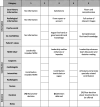Convergent parallel mixed-methods study to understand the impact of decision-making for congenital cardiac surgery patients at a tertiary paediatric hospital: a study protocol
- PMID: 40803723
- PMCID: PMC12352240
- DOI: 10.1136/bmjopen-2025-099080
Convergent parallel mixed-methods study to understand the impact of decision-making for congenital cardiac surgery patients at a tertiary paediatric hospital: a study protocol
Abstract
Introduction: Congenital heart disease (CHD) is the most common congenital condition, often necessitating complex heart surgeries that require careful planning by multidisciplinary teams. Multidisciplinary meetings (MDMs) in CHD care aim to integrate diverse expertise to optimise surgical planning. However, the lack of standardised protocols for conducting these meetings introduces undesirable variability in decision-making processes, potentially impacting patient outcomes. This study addresses the critical gap in understanding which aspects of MDMs should be standardised to ensure consistent, high-quality decision-making while also identifying areas where flexibility is essential to accommodate individual patient needs. The objective is to characterise current MDM practices in CHD care, identify factors contributing to variability and provide insights into how a balance between standardisation and flexibility can improve decision-making and patient outcomes.
Methods and analysis: A convergent parallel mixed-methods study design will be used to collect, analyse and interpret quantitative and qualitative data. Data collection will include a blend of naturalistic observations and chart reviews to track patient journeys from surgical planning through to postoperative outcomes. To complement these findings, interviews with healthcare providers will capture subjective perspectives on multidisciplinary decision-making. Additionally, departmental metrics will be collected to contextualise the broader clinical environment. Closed-ended observational and chart review data will be analysed using summary statistics and descriptive analysis (eg, percentages, means) to characterise MDM decision-making. Qualitative data (eg, reflections and learnings) from weekly post-surgical debriefs (called Performance Rounds) and clinician interviews on MDM decision-making will be analysed using a modified Framework Method.
Ethics and dissemination: Institutional research ethics approval has been acquired (REB #1000080464). To engage key stakeholders and foster collaborative improvement, study results will be shared in research rounds, where staff attending medical surgical conferences, team huddles, morbidity and mortality reviews, and Performance Rounds will be invited to participate. Targeted meetings with individual clinician groups will further allow for in-depth discussion and valuable feedback on the findings. Finally, the findings from this study are anticipated to make a meaningful contribution to the literature; a manuscript is planned for submission to a peer-reviewed journal.
Keywords: Cardiac surgery; Clinical Decision-Making; Congenital heart disease; Paediatric cardiac surgery; Paediatric cardiology; Paediatric intensive & critical care.
© Author(s) (or their employer(s)) 2025. Re-use permitted under CC BY-NC. No commercial re-use. See rights and permissions. Published by BMJ Group.
Conflict of interest statement
Competing interests: None declared.
Figures



Similar articles
-
Prescription of Controlled Substances: Benefits and Risks.2025 Jul 6. In: StatPearls [Internet]. Treasure Island (FL): StatPearls Publishing; 2025 Jan–. 2025 Jul 6. In: StatPearls [Internet]. Treasure Island (FL): StatPearls Publishing; 2025 Jan–. PMID: 30726003 Free Books & Documents.
-
[Volume and health outcomes: evidence from systematic reviews and from evaluation of Italian hospital data].Epidemiol Prev. 2013 Mar-Jun;37(2-3 Suppl 2):1-100. Epidemiol Prev. 2013. PMID: 23851286 Italian.
-
Factors that impact on the use of mechanical ventilation weaning protocols in critically ill adults and children: a qualitative evidence-synthesis.Cochrane Database Syst Rev. 2016 Oct 4;10(10):CD011812. doi: 10.1002/14651858.CD011812.pub2. Cochrane Database Syst Rev. 2016. PMID: 27699783 Free PMC article.
-
Addressing Inequalities in Long Covid Healthcare: A Mixed-Methods Study on Building Inclusive Services.Health Expect. 2025 Aug;28(4):e70336. doi: 10.1111/hex.70336. Health Expect. 2025. PMID: 40600494 Free PMC article.
-
Health professionals' experience of teamwork education in acute hospital settings: a systematic review of qualitative literature.JBI Database System Rev Implement Rep. 2016 Apr;14(4):96-137. doi: 10.11124/JBISRIR-2016-1843. JBI Database System Rev Implement Rep. 2016. PMID: 27532314
References
LinkOut - more resources
Full Text Sources
Miscellaneous
